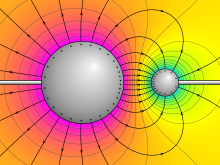Introduction to Electric Potential
– Classical mechanics explores concepts such as force, energy, and potential.
– Force and potential energy are directly related.
– A net force acting on any object will cause it to accelerate.
– As an object moves in the direction of a force acting on it, its potential energy decreases.
– Gravitational potential energy decreases as an object moves downhill.
Electric Potential in Electrostatics
– The electric potential at a point in a static electric field is given by a line integral.
– The electric field is conservative, meaning the line integral does not depend on the specific path chosen.
– The electric field points downhill towards lower voltages.
– The potential can be found to satisfy Poisson’s equation.
– Electric potential is closely linked with potential energy.
Electric Potential due to a Point Charge
– The electric potential created by a charge is given by /(4πε).
– Different values of charge yield different values of electric potential.
– The electric potential arising from a point charge at a distance from the location of the charge is observed to be /(4πε)Q/r.
– The permittivity of vacuum is denoted as ε.
– The Coulomb potential is given by /(4πε)Q/r.
Generalization to Electrodynamics
– When time-varying magnetic fields are present, the electric field cannot be expressed only in terms of a scalar potential.
– The electric field can be expressed in terms of both the scalar electric potential and the magnetic vector potential.
– The electric potential and the magnetic vector potential together form a four-vector.
– The electric potential is a continuous function in all space.
– The electric potential due to an idealized point charge is continuous in all space except at the location of the point charge.
SI Units and Other Systems of Units
– The equations for electric potential are in the forms required by SI units.
– In some other systems of units, such as CGS-Gaussian, the equations would be altered.
– SI unit for electric potential is volt (V).
– Other units for electric potential include statvolt.
– Electric potential is measured in joules per coulomb (J⋅C) or volt (V). Source: https://en.wikipedia.org/wiki/Electric_potential
Electric potential (also called the electric field potential, potential drop, the electrostatic potential) is defined as the amount of work energy needed per unit of electric charge to move the charge from a reference point to a specific point in an electric field. More precisely, the electric potential is the energy per unit charge for a test charge that is so small that the disturbance of the field under consideration is negligible. The motion across the field is supposed to proceed with negligible acceleration, so as to avoid the test charge acquiring kinetic energy or producing radiation. By definition, the electric potential at the reference point is zero units. Typically, the reference point is earth or a point at infinity, although any point can be used.
| Electric potential | |
|---|---|
 Electric potential around two oppositely charged conducting spheres. Purple represents the highest potential, yellow zero, and cyan the lowest potential. The electric field lines are shown leaving perpendicularly to the surface of each sphere. | |
Common symbols | V, φ |
| SI unit | volt |
Other units | statvolt |
| In SI base units | V = kg⋅m2⋅s−3⋅A−1 |
| Extensive? | yes |
| Dimension | M L2 T−3 I−1 |
In classical electrostatics, the electrostatic field is a vector quantity expressed as the gradient of the electrostatic potential, which is a scalar quantity denoted by V or occasionally φ, equal to the electric potential energy of any charged particle at any location (measured in joules) divided by the charge of that particle (measured in coulombs). By dividing out the charge on the particle a quotient is obtained that is a property of the electric field itself. In short, an electric potential is the electric potential energy per unit charge.
This value can be calculated in either a static (time-invariant) or a dynamic (time-varying) electric field at a specific time with the unit joules per coulomb (J⋅C−1) or volt (V). The electric potential at infinity is assumed to be zero.
In electrodynamics, when time-varying fields are present, the electric field cannot be expressed only in terms of a scalar potential. Instead, the electric field can be expressed in terms of both the scalar electric potential and the magnetic vector potential. The electric potential and the magnetic vector potential together form a four-vector, so that the two kinds of potential are mixed under Lorentz transformations.
Practically, the electric potential is a continuous function in all space, because a spatial derivative of a discontinuous electric potential yields an electric field of impossibly infinite magnitude. Notably, the electric potential due to an idealized point charge (proportional to 1 ⁄ r, with r the distance from the point charge) is continuous in all space except at the location of the point charge. Though electric field is not continuous across an idealized surface charge, it is not infinite at any point. Therefore, the electric potential is continuous across an idealized surface charge. Additionally, an idealized line of charge has electric potential (proportional to ln(r), with r the radial distance from the line of charge) is continuous everywhere except on the line of charge.
